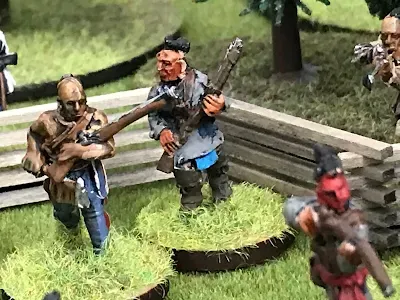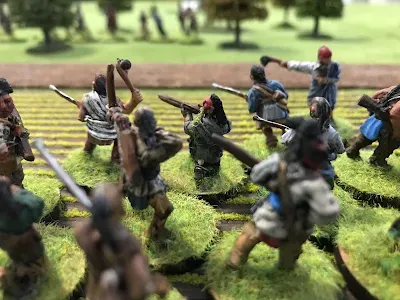One of the things that make the War of 1812 unique is the use of native warriors. The Mohawk (properly called the Kanien'kehá:ka), Cayuga, Onondaga, Oneida, Seneca and Tuscarora in the East, and the tribes of Tecumseh's federation in the West, were heavily engaged throughout the War. Native warriors fought on both sides, but primarily for the British. They are essential figures to possess in order to game the , Queenston Heights, the Thames, and numerous smaller conflicts. By the time of the War of 812,the native people's had adopted a lot of European items for their clothing. Because of this many miniatures from the French and Indian War are not quite right for the period.
There are numerous excellent Native figures on the market, mostly of the "naked savage" variety which depict traditional summer dress, which is why I only make one figure in that idiom. The remainder of my figures make an attempt to show what they would have looked like in 1812.
For summer time dress., linen shirts and Leggings and breechclouts are worn by all, but generally covered by a shirt or coat belted with a sash. Bare heads were plucked, not shaved and a small square patch of hair was left in the back of the crown, which was grown long and braided. A decorative "roach" was attached to the hair, composed of dyed porcupine quills, deer hair, and various feathers, creating a very personalized headdress. Mohaws did not have the "Mohawk" hair style we associate with them, and popularized in the movie, "Drums on the Mowhawk." Warpaint is very much in evidence, black and red being the most common colors.
It's difficult to do justice to all their wampum belts and other decorative fabrics. Sashes and belts were finely decorated, some with geometric designs and others with very sophisticated floral patterns woven into the cloth. Even loincloths (breechclouts) sported colorful stripes and geometric designs. Because of this I only paint to give an impression of these ornate designs.
In cold weather, like at the Battle of Crysler's Farm heavier shirts , wool coats or capots are worn. In addition stocking caps or head scarves cover their traditional hairstyles.



.jpeg)









.jpeg)



